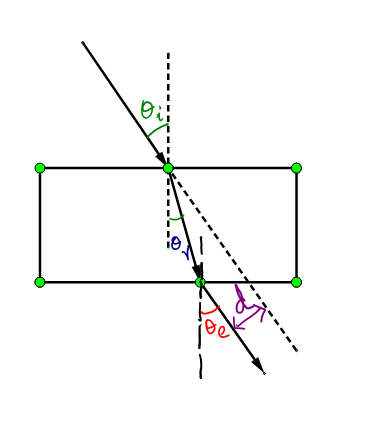
What is lateral shift? Explain the relationship between focal length and radius of curvature of a mirror.
Answer
515.8k+ views
- Hint: A shift signifies a deviation from its usual path. When we consider light its shift in the path taken by the light. You can use snell's law and some basic geometry to determine how much is the shift. To determine the relationship between focal length and radius of curvature of a mirror, draw the ray diagram of a concave mirror and determine the relationship using geometry.
Complete step-by-step solution -

So in order to understand the lateral shift, consider a denser medium bounded by a non- denser medium, for example, a glass slab placed in the air, which is made up of glass which has a higher refractive index higher than air. So when a light ray enters the glass slab from the air at an angle ${{\theta }_{i}}$, refraction takes place and the light ray inside the glass slab bends toward the normal forming an angle ${{\theta }_{r}}$with the normal. This refracted light ray when it reaches the end of the glass slab refracts again and the light bends away from the normal. We can see there is a shift in the direction of the incident ray and emergent ray. The perpendicular distance between the incident and emergent ray is known as the lateral shift. In the figure, it is denoted by ‘d’.

Consider a concave mirror with a radius of curvature at ‘R’, focus at ‘F’ and center at ‘O’. Suppose a light ray PO’ hits the surface of a mirror at O’ (O’=O, since we are considering a thin mirror). After reflection the light ray goes through F, a normal is drawn from O’ which passes through R. From the constructions we have,
$\angle PO'R=\angle RO'F=\theta $ (law of reflection) …. Equation (1)
Also $\angle O'RF=\theta $ (Alternate angles) ……..Equation (2)
From equation (1) and (2), we get
$\angle RO'F=\angle O'RF$
$\therefore \Delta O'FR$ is an isosceles triangle, with sides O’F=FR.
Since we are considering a thin mirror O’F=OF. Therefore OF=FR….. equation (3)
OF is the focal length ‘f’ of the mirror and ‘R’ is the radius of curvature.
From the figure it is clear that the radius of curvature R=OF+FR. From equation (3) we get,
$\begin{align}
& \text{R}=\text{OF}+\text{FR} \\
& \text{R}=\text{f}+\text{f} \\
\end{align}$
$\text{R}=\text{2f}$
Where, f is the focal length and R is the radius of curvature of the mirror.
Note: Concave mirrors usually give real and inverted images except when the object is placed at the focus of the mirror, so the image formed will be virtual.
Convex mirrors usually form a virtual image of the object.
Complete step-by-step solution -

So in order to understand the lateral shift, consider a denser medium bounded by a non- denser medium, for example, a glass slab placed in the air, which is made up of glass which has a higher refractive index higher than air. So when a light ray enters the glass slab from the air at an angle ${{\theta }_{i}}$, refraction takes place and the light ray inside the glass slab bends toward the normal forming an angle ${{\theta }_{r}}$with the normal. This refracted light ray when it reaches the end of the glass slab refracts again and the light bends away from the normal. We can see there is a shift in the direction of the incident ray and emergent ray. The perpendicular distance between the incident and emergent ray is known as the lateral shift. In the figure, it is denoted by ‘d’.

Consider a concave mirror with a radius of curvature at ‘R’, focus at ‘F’ and center at ‘O’. Suppose a light ray PO’ hits the surface of a mirror at O’ (O’=O, since we are considering a thin mirror). After reflection the light ray goes through F, a normal is drawn from O’ which passes through R. From the constructions we have,
$\angle PO'R=\angle RO'F=\theta $ (law of reflection) …. Equation (1)
Also $\angle O'RF=\theta $ (Alternate angles) ……..Equation (2)
From equation (1) and (2), we get
$\angle RO'F=\angle O'RF$
$\therefore \Delta O'FR$ is an isosceles triangle, with sides O’F=FR.
Since we are considering a thin mirror O’F=OF. Therefore OF=FR….. equation (3)
OF is the focal length ‘f’ of the mirror and ‘R’ is the radius of curvature.
From the figure it is clear that the radius of curvature R=OF+FR. From equation (3) we get,
$\begin{align}
& \text{R}=\text{OF}+\text{FR} \\
& \text{R}=\text{f}+\text{f} \\
\end{align}$
$\text{R}=\text{2f}$
Where, f is the focal length and R is the radius of curvature of the mirror.
Note: Concave mirrors usually give real and inverted images except when the object is placed at the focus of the mirror, so the image formed will be virtual.
Convex mirrors usually form a virtual image of the object.
Recently Updated Pages
A man running at a speed 5 ms is viewed in the side class 12 physics CBSE

The number of solutions in x in 02pi for which sqrt class 12 maths CBSE

State and explain Hardy Weinbergs Principle class 12 biology CBSE

Write any two methods of preparation of phenol Give class 12 chemistry CBSE

Which of the following statements is wrong a Amnion class 12 biology CBSE

Differentiate between action potential and resting class 12 biology CBSE

Trending doubts
What are the major means of transport Explain each class 12 social science CBSE

Which are the Top 10 Largest Countries of the World?

Draw a labelled sketch of the human eye class 12 physics CBSE

How much time does it take to bleed after eating p class 12 biology CBSE

Explain sex determination in humans with line diag class 12 biology CBSE

Explain sex determination in humans with the help of class 12 biology CBSE




